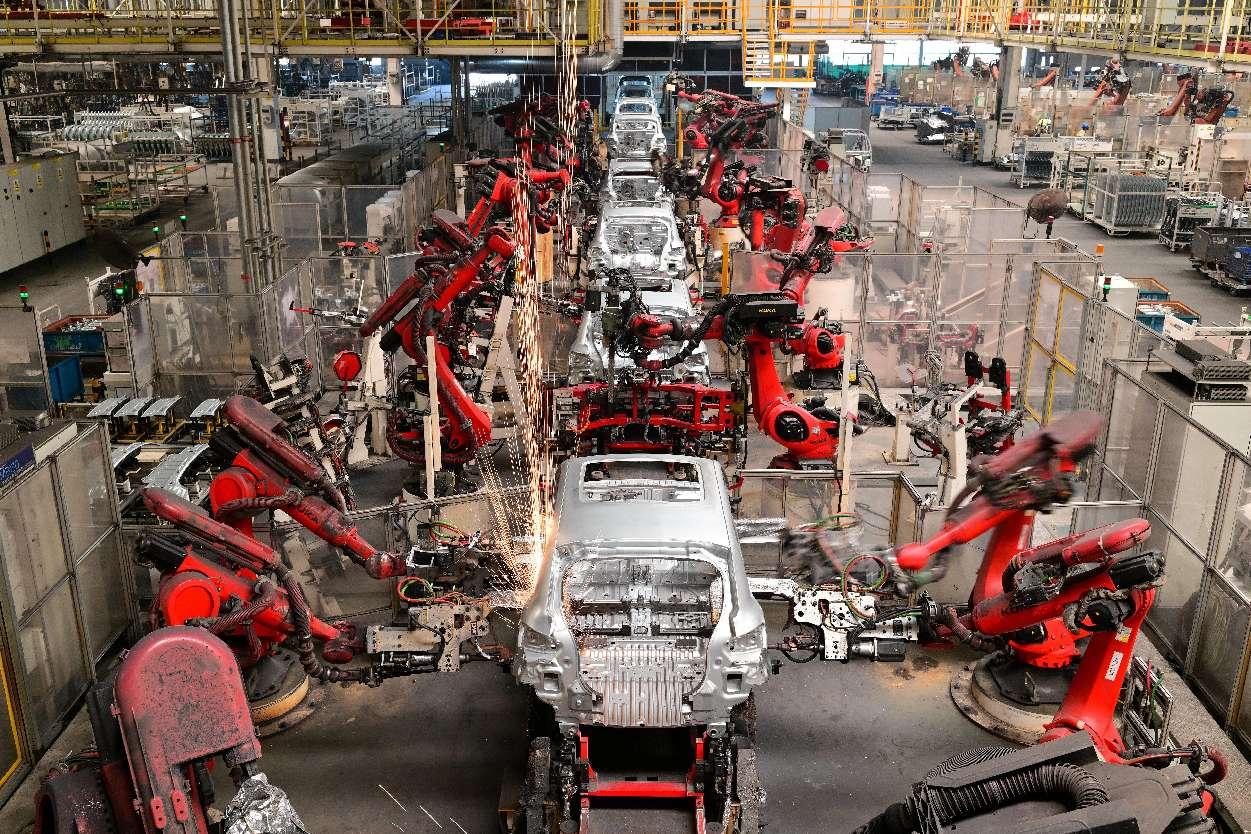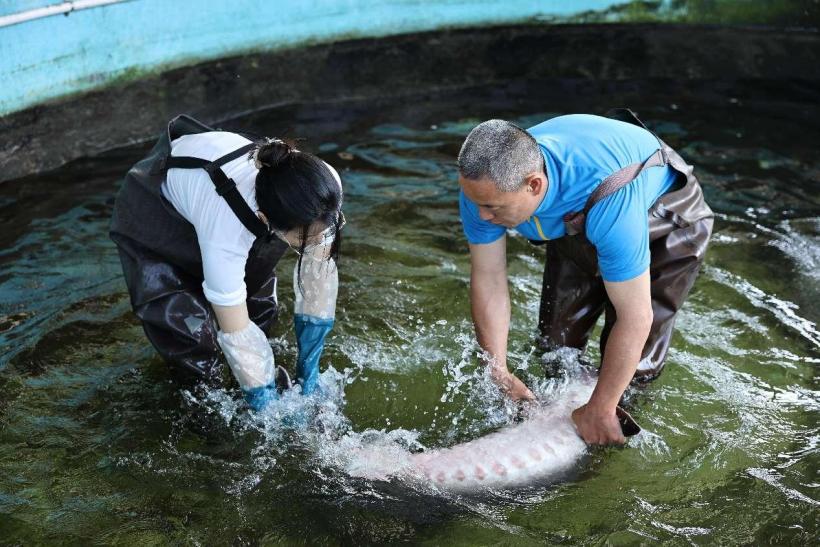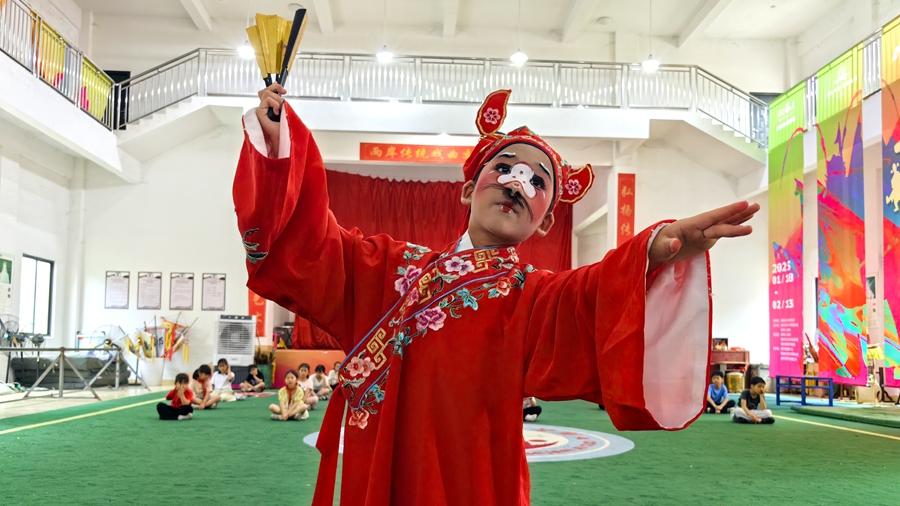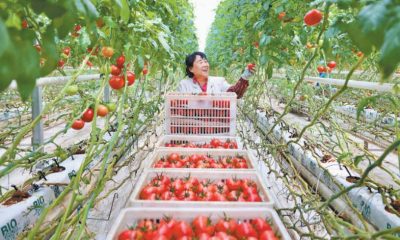Foreign
China’s trade, auto data highlight bright prospects of Chinese economy

By Ren Ping, People’s Daily
Despite the ongoing global economic headwinds, recent data from two key sectors provide compelling evidence of China’s resilient economic trajectory.
On May 12, the China Association of Automobile Manufacturers reported that, for the first time ever, both production and sales of automobiles in China surpassed 10 million units in the first four months of the year, a year-on-year increase of 12.9 percent and 10.8 percent, respectively. Among these, exports of new energy vehicles (NEVs) reached 642,000 units, up 52.6 percent from a year ago.
The robust performance of the auto sector, a strategic and pillar industry, reflects the deeper logic behind China’s high-quality development.
Additionally, customs data released on May 9 showed that China’s total goods imports and exports in yuan-denominated terms expanded 2.4 percent year on year in the first four months of this year. In April alone, China’s foreign trade was up 5.6 percent year on year, with exports rising 9.3 percent.
Despite global uncertainties, particularly in trade, China’s manufacturing and innovation strengths have allowed the country to sustain its economic momentum.
Reuters reported that China’s factory output showed surprising resilience in April, a sign that government support measures may have cushioned the impact of a trade war with the United States.
Together, these data points not only reflect the resilience of the Chinese economy but also its promising outlook for the future.
China’s confidence in tackling risks and challenges stems from effective macroeconomic policy and capable governance.
According to China’s Ministry of Commerce, the total number of applications for auto trade-in subsidies in China exceeded 10 million by May 11, under a mass renewal program initiated in 2024. International media outlets said this program has been particularly effective in counteracting the negative effect of U.S. tariffs on consumer confidence.
Beyond facilitating millions of vehicle upgrades, the program has significantly boosted sales of durable goods. In the first quarter, the policy helped drive a 19 percent year-on-year increase in investment in equipment and tools, and contributed to a 4.6 percent rise in total retail sales of consumer goods.
Moreover, the synergy between technological innovation and industrial upgrading is unlocking new momentum.
China’s auto industry today is experiencing a surge in technological innovation, with major advancements being made in electric vehicle (EV) technology.
For instance, Chinese EV battery giant CATL recently launched a new brand for its sodium-ion battery with a life cycle of over 10,000 charges and performance evenin extreme temperatures as low as minus 40 degrees Celsius. Inside a welding workshop of Chinese automaker Guangzhou Automobile Group Co., Ltd. (GAC Group) in Yichang, cemtral China’sHubei province, over 500 robots work in sync, producing a new car every 52 seconds.
The shift toward high-end, intelligent, and green production is rapidly becoming standard practice. A more dynamic equilibrium — where supply responds to demand and demand drives new supply — has transitioned from a theoretical ideal to practical reality.
At the recently concluded 21st Shanghai International Automobile Industry Exhibition(Auto Shanghai 2025), over 100 new models made their global debut, with over 70 percent being NEVs. Cutting-edge technologies were everywhere at the event. As Germany’s Die Welt commented, anyone visiting Auto Shanghai 2025 would feel that the future has already come to China.
From technology importer to exporter, from attracting investment to making overseas investment, and from adapting to standards to setting them, China is gaining new competitive advantages and expanding its role in global cooperation.
In the first four months of 2024, China’s high-tech exports rose 7.4 percent year on year, accounting for around 20 percent of the country’s total exports and contributing to a 1.3percentage point rise in overall export growth. This thriving “innovation ecosystem” is central to China’s ability to navigate economic cycles and mitigate risks.
Green and low-carbon development is not only a long-term solution to environmental challenges but also a global trend. From January to April, China’s NEV output and sales both exceeded 4 million units, marking a year-on-year growth of over 45 percent.
Chinese NEV manufacturers are intensifying efforts in renewable energy, energy efficiency, material recycling, and technological upgrades to reduce carbon emissions throughout the supply chain. NEVs are now ubiquitous on Chinese streets, and more and more young Chinese are choosing NEVs as their first cars.This symbiotic relationship between green production and green lifestyles is accelerating.
Besides, Chinese manufacturing and global demand are also mutually reinforcing.
In the first quarter of this year, major destinations for Chinese auto exports included Mexico, the United Arab Emirates, Russia, Belgium, Saudi Arabia, Brazil, and Australia. A popular Brazilian auto influencer recently remarked that Chinese NEVs are becoming a new choice for car buyers in Brazil. Ricardo Bastos, president of the Brazilian Association of Electric Vehicles, emphasized: “We need clean energy to replace fossil fuels. This industrial transformation is sweeping the world.”
By embracing the opportunities presented by digital and green transformation and by leveraging both global and domestic markets, Chinese smart manufacturing is not only meeting people’s aspirations for a better life but also playing a pivotal role in the global transition to clean mobility.
Foreign
Henan advances high-quality development through real economy

By Wang Lewen, Fang Min, Bi Jingjin, People’s Daily
In the heart of central China, Henan province has made significant strides toward high-quality development, anchored firmly in the real economy. From major industrial hubs to advanced infrastructure projects, the province’s development momentum is palpable across the central plains.
At a construction site in Luoyang, the second phase of Chinese battery giant CATL’s facility is rapidly taking shape, with tower cranes punctuating the skyline. Meanwhile, in the Zhengzhou Airport Economy Zone, the hum of machinery fills the air as construction activities intensify to establish the Central China Medical Science District.
Henan has prioritized the real economy as the cornerstone of its economic strategy. By leveraging project development as a principal mechanism, the province has actively expanded effective investment and invigoratedthe drivers for stabilizing economic growth.
In 2024, Henan launched 16,800 major projects across various stages of development, encompassing contract signing, groundbreaking ceremonies, and production commencements. Among them, 9,718 projects pertain to advanced manufacturing. Key indicators, including fixed-asset and industrial investment,outpaced the Chinese national average, underscoring the province’s economic momentum.
In Mengzhuang township, Huixian, construction is underway on a smart logistics hub for Chinese e-commerce giant JD.com. Two large warehouses have been completed, the main building has reached structural completion, and other auxiliary facilities are advancing at a steady pace.
With a total investment of over 600 million yuan ($83.32 million), the project encompassessix centers, two bases, and one headquarters. Construction commenced in 2024, with some facilities already operational, generating thousands of jobs.
“We are striking a balance between quick wins and long-term vision,” said Tian Dongfang, director of the township’s economic development office. “Our goal is to build a comprehensive logistics hub for northern Henan, with massive growth potential.”
This equilibrium between short-term accomplishments and forward-lookingplanning underpins Henan’s confidence in its development trajectory. The province maintains a strategicapproach in the formulation and preparation of major projects.
“Henan always keeps a strong pipeline of major projects across key sectors. We maintain a reserve of at least 100 high-quality projects, revising the list every six months based on evolving needs,”explained an official with the Development and Reform Commission of Henan Province.
The province has released its list of key construction projects for 2025, identifying 1,037 provincial-level projects with a combined investment of around 3.1 trillion yuan. It aims to complete investments totaling approximately 1 trillion yuan within the year.
Henan is also capitalizing on its intrinsic advantages to reinforce its development strengths.With a well-establishedindustrial base, the province successfully attracted Chinese automaker SAIC Motor to build a new energy battery plant in Zhengzhou. Concurrently, the province is expediting the development of a 10-billion-yuan food industrial park in Luohe’sYancheng district, harnessing its abundant agricultural resources.
Innovation, infrastructure enhancement, and industrial transformation remain central to Henan’s priorities. The province targets the production of 2 million vehicles in 2025, including 1.4 million new energy vehicles. Meanwhile, it is accelerating construction of major projects such as an ethylene production facility and a fluorosilicon materials complex in Luohe, alongside critical infrastructure projects including the Yellow River Crossing Projectand Phase I project at Zhoukou Central Port.
While expanding itsoverall economic scale, Henan equally emphasizes the qualitative aspects of growth. By upgrading project structures, the province is elevating the standard of industrial development.
At Zhengzhou Hengda Intelligent Control Technology Co., Ltd., a manufacturer specializing in smart control systems for coal mining operations, research personnel now outnumber production workers by a ratio of five to one, resulting in a 67 percent increase in per capita productivity.
The company faced constraints such as limitedgrowth capacity and low automation levels. To facilitate its development, the Zhengzhou Economic and Technological Development Zone designated the construction of a new facility for Hengda Intelligent Control as a key advanced manufacturing project, providing strong policy support and logistical facilitation.
“With more automated and digitalized equipment, we’ve been able to deploy our workforce toward research, development and services,” said Lian Donghui, general manager assistant of the company.
“When planning and executing projects, our primary focus remains industrial development,” said Chen Bo, director of the Henan provincial government’s office for key project construction.
According to Chen, a single major project can serve as a catalyst for new growth, while a cluster of such projects can establish a new economic growth pole. The province actively encourages upstream and downstream businesses to co-locate in proximity to core projects, thereby accelerating cluster-based industrial development.
In Luoyang’sYibin district, a white freight truck loaded with new energy batteries departed the Phase I facility of CATL’s Luoyang base. This flagship project has attracted nine affiliated enterprises along the industrial chain, which have signed agreements to establish operations in the vicinity. As a result, a large-scale new energy battery industrial cluster, with an expected output value of over 100 billion yuan, is rapidly emerging in the city.
High-quality, large-scale projects are providing a firm foundation for Henan’s efforts to stabilize growth, improve its economic structure, and foster new growth drivers. In 2024, the value added of industrial enterprises above the designated size in the province rose 8.1 percent year on year. Fixed-asset investment grew 7 percent, while the value added of strategic emerging industries and high-tech manufacturing increased by 9.2 percent and 12 percent, respectively.
Foreign
Biodiversity continues to recover in Yangtze river as fishing ban reaches fifth year

By Yu Jingxian, Fan Haotian, Xu Jing, People’s Daily
May marks the peak breeding season for fish species in key areas of the Yangtze River Basin, including the main river, tributaries, and major connected lakes.
As China’s longest river, the Yangtze River plays an indispensable role in the country’s ecological well-being. In 2021, a decade-long fishing ban was fully implemented across key conservation areas of the river to restore its ecosystem. Now in its fifth year, the effort is showing tangible results.
According to the latest data, the average fishery resource volume at monitoring sites along the river’s main stem rose by 9.5 percent year on year in 2024. From 2021 to 2024, 344 native fish species were monitored in the basin, an increase of 36 species compared to the 2017 to 2020 period which preceded the fishing ban.
Supported by conservation efforts across the entire basin, the Yangtze River is gradually recovering its ecological vitality and fostering renewed harmony between human activities and natural systems.
Early in the morning in Jiangtun bay of Yangye township, Ezhou, central China’s Hubei province, several Yangtze finless porpoises frolicked in the river, occasionally poking their heads above the water.
“The water quality has improved a lot in recent years. These ‘smiling angels,’ once rarely seen, now appear regularly,” said local resident Li Congguo, proudly showing a video clip of the porpoises captured on his phone.
The Yangtze finless porpoise – widely regarded as a flagship species – serves as a critical barometer of the river’s ecological health. Jiangtun bay, with its gentle currents and abundant aquatic resources, is one of the important natural habitats of the porpoise in the river’s middle and lower reaches.
“We plan to install panoramic cameras to enable real-time public observation of the porpoises. In the future, we’ll also explore eco-tourism and educational initiatives to further promote awareness and protection of the species,” said Yan Jian, head of Yangye township.
Conservation efforts are intensifying for other iconic species, including the Chinese sturgeon and Yangtze sturgeon.
For the first time, over one million Chinese sturgeons were released into the river last year, and an estimated 110,000 juveniles successfully migrated to the sea via the Yangtze estuary. In areas like Poyang Lake and Dongting Lake, emergency rescue operations for Yangtze finless porpoises were conducted during dry seasons, combining in-situ and ex-situ protection strategies.
The fishing impacts the livelihoods of more than 200,000 fishermen who lived along the river. How have their lives evolved in the aftermath?
At a “fish-to-farming” base in Huyang township, Dangtu county, Ma’anshan, east China’s Anhui province, Ma Wuyi, in his fifties, was weeding a crab pond. Six years ago, he was a seasoned fisherman. In 2019, as part of a government initiative to relocate fishermen away from the Yangtze River and its tributaries, Ma relinquished his nets and moved into a resettlement community with his family.
The county also launched supportive policies to facilitate career transitions, particularly toward aquaculture.Ma participated in free training courses on fish and crab farming,organized by the county and township governments. To address the challenges of vocational adaptation, Dangtu county established a technical support team at the aquaculture base, assigning experts to each former fisherman to provide free guidance on pond disinfection, feeding, disease control, and more.
This farming season, Mastocked his ponds with about 850 kilograms of crab fry and over 300 kilograms of shrimp fry. “The crabs are growing well. It’s only May, and the biggest already weighs about 75 grams. I’m optimistic about this year’s harvest,” he said.
Since the full implementation of the ten-year fishing ban, local governments have worked to ensure the proper resettlement and support of former fishermen. Continuous follow-up studies and poverty prevention monitoring have been carried out.
By the end of the first quarter of this year, all 145,000 former fishermen nationwide with both the ability and willingness to work had found new employment. All 220,000 eligible former fishermen had been enrolled in basic pension insurance, and 12,000 fishermen facing financial difficulties had been included in the Chinese national subsistence allowance system.
Rehabilitating the ecological health of the Yangtze River requires attention to both aquatic and terrestrial sources degradation. In recent years, provinces along the river and relevant departments have undertaken coordinated efforts to restructure local economies. Thousands of chemical plants have been shut down, relocated, upgraded, or repurposed to enable green development.
At the Baiyang Industrial Park in Yichang Hi-tech Industry Development Zone, central China’s Hubei province, construction is underway on a fluorosilicone materials facility. “This relocation is not just about a geographic shift – it represents a comprehensive upgrade toward high-end, smart, and green production,” said Huang Zhiliang, deputy chief engineer of Hubei YiHua Group. The company has invested 112 million yuan ($15.6 million) in building a smart chemical plant, which is expected to conserve the equivalent of 110,000 metric tons of standard coal annually.
Experts emphasize that the fishing ban has fundamentally curtailed overfishing. However, the Yangtze River’s full ecological recovery remains a long-term endeavor. Challenges such as blocked migration routes, water pollution, and habitat destruction continue to pose significant threats to biodiversity.
Foreign
ASEAN-China-GCC Summit groundbreaking act of solidarity, self-strengthening for global south

By He Yin, People’s Daily
On May 27, the ASEAN (the Association of Southeast Asian Nations)-China-GCC (the Gulf Cooperation Council) Summit was held in Kuala Lumpur, Malaysia.
This unprecedented trilateral summit reflected the growing trend of multipolarity and marked a groundbreaking initiative in regional economic cooperation as the Global South rises.
The establishment of a trilateral cooperation mechanism among China, ASEAN, and the GCC, and the deepening of their trilateral partnership, will not only promote economic prosperity for all sides, but also contribute to peace and development in Asia and beyond.
This was the first-ever summit among China, ASEAN, and the GCC. At a time when a few major countries are undermining global economic cooperation through protectionism and threatening international stability through unilateralism, the convening of a cross-regional summit by China, ASEAN, and the GCC – fellow members of the Global South – stood as a pioneering act of unity and self-empowerment.
It has sent a strong signal that countries of the Global South are becoming more proactive in safeguarding common interests and advancing shared development.
Together, China, ASEAN and the GCC account for roughly a quarter of the world’s population and economic output, serving as a powerful force for openness and cooperation. The growing cooperation among the three parties builds on a rich historical legacy, rests on strong practical foundations, and responds to the needs of the times.
China and ASEAN are each other’s largest trading partners, and the two sides have fully completed negotiations on the Version 3.0 China-ASEAN Free Trade Area. China is also the GCC’s largest trading partner and is advancing free trade agreement negotiations with the bloc.
As beneficiaries of economic globalization, all three parties understand the vital importance of deepening interregional economic cooperation under the current global circumstances. By steadfastly expanding regional opening up and fully connecting their respective markets, the three sides can unlock vast new development opportunities and generate strong synergy. As an ASEAN media outlet noted, “the combined strength of the three parties could reshape the global economic landscape.”
In today’s world, geopolitical tensions are intensifying, unilateralism and protectionism are on the rise, and talks of “decoupling,””severing supply chains,” and “building up fences and barriers”are becoming more frequent, constraining the development space of Global South countries.
The summit adopted a joint statement, in which the three parties, with firm resolve, pledged to advance the spirit of inclusivity, sustainability, resilience and equal partnership, charting a united and collective path toward a peaceful, prosperous and equitable future. It demonstrates the parties’ joint commitment to multilateralism and fairness and justice.
Some media outlets observed that the summit highlighted Asia’s growing role as a balancing force in the evolving international landscape. As the largest developing country, China is committed to working with ASEAN and GCC countries to safeguard the common interests of the vast number of developing countries, resolutely oppose hegemonism and power politics, and promote a more just and equitable global governance system.
Indonesian President Prabowo Subianto highly commended China’s role, noting that “China has always defended the interests of developing countries.”
China’s high-quality economic development is injecting new momentum into trilateral cooperation.
Since the beginning of this year, China’s economy has continued its upward recovery trajectory. In the first quarter, its GDP grew by 5.4% year on year, one of the fastest among all major economies. All participants in the summit expressed strong confidence in China’s development prospects and hope to seize the opportunities presented by the new cooperation mechanism.
The Joint Statement of the ASEAN-China-GCC Summit clearly states the parties’ commitment to promoting high-quality cooperation under the Belt and Road Initiative and seamless connectivity.
To date, all ten ASEAN countries and GCC member states have signed Belt and Road cooperation documents with China. Accelerating the alignment of the Belt and Road Initiative with each party’s development strategies will further unleash development potential and enhance resilience.
As demonstrated by China’s newly introduced visa facilitation measures for ASEAN and GCC citizens, China remains committed to high-standard opening up and will continue to roll out more initiatives for both voluntary and unilateral opening up, allowing all sides to share the dividends of China’s development.
As changes unseen in a century continue to accelerate, cooperation is the only correct path to overcoming shared challenges. The establishment of a trilateral cooperation mechanism among China, ASEAN, and the GCC will foster deeper openness and collaboration, promote stronger collective responsibility, and inject powerful momentum into the shared development and prosperity of all three parties. It will bring greater benefits to their peoples and contribute more significantly to peace and development in Asia and the wider world.
-

 Foreign10 hours ago
Foreign10 hours agoXinjiang embraces innovation to modernize agriculture
-

 Foreign4 hours ago
Foreign4 hours agoXinjiang embraces innovation to modernize agriculture
-
Foreign10 hours ago
China’s bearing industry shifts into high gear for high-end development
-

 Foreign28 mins ago
Foreign28 mins agoASEAN-China-GCC Summit groundbreaking act of solidarity, self-strengthening for global south
-

 Foreign20 mins ago
Foreign20 mins agoBiodiversity continues to recover in Yangtze river as fishing ban reaches fifth year






